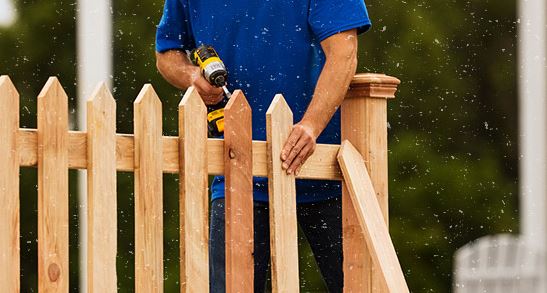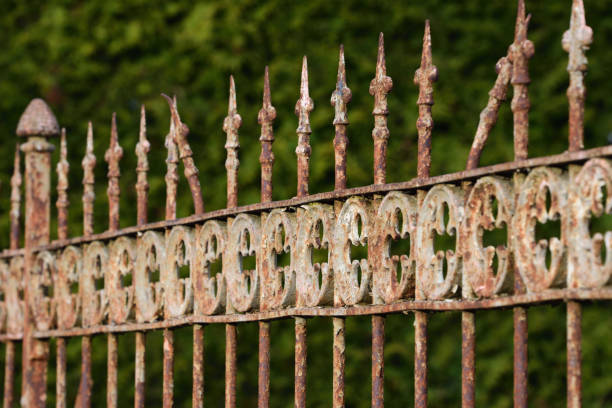Fence Repair & Rust Prevention Guide | Jacksonville Handyman

Owning a coastal home in Jacksonville Beach is a lifestyle choice you’ll never regret—but the ocean breeze that makes evenings perfect also brings salt, sand, and humidity that are relentless on exterior features, especially fences. Without the right materials, coatings, and maintenance plan, corrosion and structural wear can sneak up fast. That’s why getting proactive about fence repair and rust prevention isn’t just about curb appeal—it’s about protecting your property from safety hazards and long-term costs.
If your fence is leaning, rust is showing through the paint, or gates no longer latch cleanly, those are early warning signs to act now. Mark of Jax Beach Handyman has helped homeowners across Jax Beach and surrounding neighborhoods diagnose corrosion issues, repair failing posts, and set up simple maintenance routines that actually hold up to the coast. When in doubt, a quick visit from a jacksonville handyman can save you from much bigger repairs later.
Why Do Jacksonville Beach Fences Need Special Care?

How do sand, sea salt, weather cycles, and humidity accelerate fence wear?
Coastal environments supercharge deterioration. Salt particles carried by wind cling to metal and wood. Add high humidity and frequent rain, and you’ve got the perfect recipe for moisture retention and corrosion. Sand acts like an abrasive, scuffing protective finishes on posts and rails. Temperature shifts—sun-baked afternoons followed by cool, damp nights—cause expansion and contraction that open micro-cracks, making it easier for water and salt to penetrate. Storm season adds the final stress test with gusts, wind-driven rain, and standing water.
How do wood and metal react to coastal exposure?
Wood swells when it absorbs moisture and shrinks as it dries, which can warp pickets and rails or loosen fasteners. Untreated or poorly sealed wood becomes a home for mildew and rot. Metals like steel and iron oxidize on contact with oxygen and moisture—salt accelerates that reaction dramatically. Aluminum resists rust, but cheap alloys and dissimilar fasteners can still corrode where they meet steel or copper. Vinyl doesn’t rust, but UV exposure can make lower-quality products brittle over time, and sand can scuff the surface if not rinsed.
What Are the Most Common Fence Problems in Coastal Areas?
Jacksonville Beach homeowners see a predictable list of fence failures—most of which are preventable if caught early:
- Corrosion on hardware and metal panels: rust on hinges, latches, brackets, and exposed welds.
- Warped or cupped wood pickets: swelling and shrinking cycles deform boards and open gaps.
- Loose or rotted posts: saturated soil and poor drainage weaken posts, causing lean.
- Leaning or racking panels: wind load and loose fasteners shift the fence out of plumb.
- Flaking paint and failed coatings: UV and sand wear down protective layers.
- Gate misalignment: sagging posts and corroded hinges cause latching issues.
How Does Rust Form and What Causes It in Fencing?

Rust is the oxidation of iron and steel, accelerated by water and oxygen. In Jacksonville Beach, airborne salt acts like a catalyst. Microscopic salt crystals draw moisture from the air and hold it on the metal surface, keeping it wet longer and creating an electrolyte that speeds corrosion. Scratches, drilled holes, cut ends, and welds are especially vulnerable if they weren’t properly primed and sealed. Mixed-metals contact—say, steel screws in aluminum posts—can cause galvanic corrosion, where the less noble metal becomes a sacrificial anode and deteriorates faster.
What Type of Fencing Material Is Best for Beachfront Properties?
The right material depends on your goals for privacy, durability, aesthetics, and budget. Here’s a quick comparison of the top choices for coastal use:
| Material | Pros | Cons | Best Use |
|---|---|---|---|
| Pressure-Treated Wood (PT) | Cost-effective, customizable, warm look | Needs sealing; can warp/rot; hardware corrodes | Privacy fences with diligent maintenance |
| Cedar or Cypress | Natural rot resistance, stable grain | Higher upfront cost; still needs sealing | Premium look; better stability than PT |
| Powder-Coated Aluminum | Won’t rust; light; low maintenance | Less privacy; cheaper alloys can pit near ocean | Perimeter & pool fences; modern profiles |
| Galvanized + Powder-Coated Steel | Very strong; good for security | Must protect cut ends; can rust if coating fails | High-wind areas; decorative iron-look styles |
| Vinyl (PVC) | No rust; privacy; easy to clean | Can yellow or chalk; impact cracking in cheap panels | Privacy and semi-privacy, low upkeep |
| Composite (wood-plastic) | Resists rot; stable; premium look | Expensive; needs quality fasteners/posts | Long-term privacy with minimal upkeep |
For many coastal homeowners, powder-coated aluminum paired with stainless hardware offers the best corrosion resistance, while composite or high-quality vinyl provides privacy with less maintenance than wood. If you prefer wood’s warmth, choose rot-resistant species and a robust sealing plan, and use stainless or coated fasteners. For site-specific advice, consult a local pro or a jacksonville handyman who understands our soil, wind exposure, and salt patterns.
What Preventive Measures Help Stop Fence Rusting?
Which coatings and treatments actually work near the ocean?
- Galvanization: Hot-dip galvanized steel forms a zinc barrier; for cut ends and field-drilled holes, touch up with zinc-rich primer.
- Powder coating: Factory-applied powder coats on aluminum and steel are highly durable—inspect for chips and touch up promptly.
- Marine-grade paints and epoxies: Two-part epoxies or marine enamels resist salt and moisture better than standard exterior paint.
- Wood sealers: Use UV-blocking, penetrating oil sealers or high-solids exterior stains; reapply every 12–24 months depending on exposure.
What’s the right fastener and hardware strategy?
- Pick stainless steel (316 for highest corrosion resistance) for screws, nails, and hinges, especially within a few blocks of the shoreline.
- Avoid mixed metals when possible; if you must mix, use isolating washers or coatings to reduce galvanic reactions.
- Seal hardware penetrations with exterior-grade sealant to keep water out of wood fibers.
What maintenance schedule keeps fences intact?
- Quarterly rinse: Hose down metal and vinyl to remove salt film; soft brush if needed. Avoid pressure washers on soft wood.
- Biannual inspection: Check for hairline cracks in coatings, loose fasteners, gate alignment, and soil erosion around posts.
- Annual touch-up: Spot-prime rust, re-caulk cracks at joints, and re-seal high-exposure wood.
- Post-storm checklist: Re-tighten hardware, re-level posts, and clean out sand/wind-driven debris at the base.
What Are Signs Your Fence Needs Immediate Repair?

Don’t wait if you spot any of the following. Handling these early is far cheaper than a full replacement:
- Flaking or bubbling paint on metal—often the first sign of underlying rust.
- Orange staining at screw heads, hinge leaves, and welds.
- Soft wood around post bases or horizontal rails that “give” when pressed.
- Lean greater than 2–3 degrees or panels that “rack” out of square.
- Gate sag or latch failure caused by corroded hinges or shifting posts.
- Visible cracks at post-concrete interface or heaving from poor drainage.
How Much Does Fence Repair Typically Cost in Jacksonville Beach?
Actual pricing depends on material, extent of corrosion, accessibility, and whether sections must be replaced. Here are typical local ranges to help you plan:
| Repair Type | Typical Range (Labor + Materials) | Notes |
|---|---|---|
| Hardware replacement (hinges/latches) | $150–$450 per gate | Stainless upgrades cost more but last longer |
| Spot rust removal + touch-up coating | $200–$600 per section | Includes prep, primer, and matching finish coat |
| Post re-set (concrete footing) | $250–$600 per post | Higher if excavation needed or access is tight |
| Panel replacement (wood or vinyl) | $200–$800 per panel | Depends on height, style, and material availability |
| Aluminum rail or picket replacement | $250–$700 per section | Premium powder-coat colors increase cost |
| Full refinish/reseal (wood) | $3–$7 per sq. ft. | Includes cleaning, sanding (as needed), stain/seal |
Pro tip: Bundle multiple repairs and preventive coating work in one visit to reduce mobilization costs. For a precise estimate, consult a trusted jacksonville handyman familiar with coastal exposures, HOA requirements, and local suppliers.
What Are Budget-Friendly Fixes for Coastal Fence Damage?
- Spot priming and sealing: Catch small rust blooms early. Remove rust to bare metal, apply zinc primer, then a marine-grade topcoat.
- Hardware upgrade: Replace only the corroded pieces with stainless steel; it’s cost-effective and prevents repeat failures.
- Partial panel repair: Replace a few damaged pickets or rails instead of an entire section—especially on wood fences.
- Drainage improvements: Add gravel at post bases, clear mulch away from posts, and redirect downspouts—cheap and effective.
- Rinse routine: A 10-minute hose-down every few weeks drastically reduces salt buildup.
- Phased repairs: Prioritize safety issues (leaning posts, broken gates), then plan cosmetic and coating work in stages.
Why Hiring a jacksonville handyman Expert Is the Smart Choice

What do regular inspections catch that DIY might miss?
Pros look for early-stage failures hidden in plain sight—hairline coating cracks on shaded sides, galvanic corrosion around mixed-metal fasteners, and tiny shifts in post alignment that indicate footing problems. Catching these before they widen saves hundreds in labor and materials.
How does coastal experience change the repair plan?
Coastal pros know which products actually last near the ocean. That means choosing 316 stainless over basic stainless for certain gates, using zinc-rich primers at all cut edges, and selecting sealants that remain flexible under thermal cycling. They’ll also time work to humidity and temperature windows so coatings cure properly.
Why does material knowledge matter?
From powder-coat thickness to the right fastener threads for composite posts, material details determine lifespan. A seasoned expert will spec compatible fasteners and isolation barriers, choose UV-resilient finishes, and verify clearances so gates don’t bind as posts move with moisture.
How a Local Pro Helps with Fence Repair and Rust Prevention
A reliable coastal technician will start with a thorough assessment: soil conditions, fence alignment, hardware corrosion, coating failures, and water-shedding paths. Expect a prioritized action plan—stabilize posts and gates first, then address corrosion hotspots, and finally apply long-term protective finishes. You’ll also get a maintenance calendar tailored to your property’s distance from the shore, prevailing winds, and shade patterns. This keeps costs predictable and prevents the cycle of emergency fixes.
How Can Fence Damage Affect Other Areas of Your Property?
Fences don’t fail in isolation. When pickets gap or posts loosen, wind-driven rain and salt spray reach areas they used to shield. That exposure can accelerate siding wear, allow water intrusion at trim, and even contribute to minor flooding pathways in heavy storms. Keeping your fence in good shape helps protect the whole envelope of your home.
- Interior impacts: Moisture that bypasses deteriorated fencing or gates can find its way into garages or low-entry points, eventually showing up as wall or ceiling damage. If you’re already seeing bubbling paint or joint lines inside, visit Jacksonville Handyman Guide: Drywall Repair for Beach Homes for corrective steps and prevention.
- Exterior seal defense: A compromised fence can direct splashback against siding and trim. Learn how to maintain watertight exteriors in Protect Your Jax Beach Home: Coastal Painting & Caulking Guide.
Visual Overview: Seasonal Fence Maintenance Checklist
Use this simple seasonal plan to stay ahead of coastal wear. Print it, stick it in the garage, and set quarterly reminders on your phone.
Spring
- Rinse entire fence and hardware to clear winter salt film.
- Inspect posts for movement after winter rains; re-level as needed.
- Touch up coatings where chips or scratches appear.
- Lubricate gate hinges and verify latch alignment.
Summer
- Deep clean metal and vinyl surfaces; soft-brush sand scuffs.
- Apply UV-protective sealer to wood; focus on sun-facing sides.
- Check for expansion-related gate binding; adjust hardware.
- Trim vegetation to promote airflow and faster drying.
Fall
- Pre-storm prep: tighten fasteners, secure gates, verify clearances.
- Re-seal vulnerable wood joints and fastener penetrations.
- Confirm drainage: slope grade away from posts; add gravel if needed.
- Schedule any needed professional coating or structural repairs.
Winter
- Monthly quick rinse on calm days to limit salt buildup.
- Check for standing water near post bases after heavy rain.
- Spot-prime any new rust immediately; don’t wait for spring.
- Plan spring upgrades and budget for stainless hardware swaps.
Simple chart: perceived rust risk by season (higher bars = more proactive care)
Spring : ███████ Summer : ██████ Fall : █████████ Winter : █████
Note: Fall brings storm threats; spring’s frequent showers and pollen add wear too. Even winter has steady salt exposure on windy days.
Futureproofing: What Are the Long-Term Benefits of Preventive Fence Care?
- Lower lifetime cost: Regular rinse-and-seal routines reduce emergency callouts and panel replacements.
- Better structural integrity: Tight fasteners and healthy posts keep gates aligned and panels square, extending lifespan.
- Improved curb appeal and value: A clean, rust-free fence signals a well-maintained property to buyers and appraisers.
- Storm resilience: Reinforced posts and corrosion-resistant hardware help the fence withstand high winds and driving rain.
- Healthier exterior envelope: Less splashback and water intrusion means fewer siding, trim, and interior repair issues.
FAQs: What Do Jacksonville Beach Homeowners Ask Most?
How often should I rinse my fence near the coast?
Every 2–4 weeks is ideal within a mile of the ocean, especially for metal and vinyl. Wood benefits from gentle rinsing too—avoid high pressure to prevent fiber damage.
What’s the best paint or coating for metal fencing here?
Start with thorough prep and a zinc-rich primer on bare steel, then use a marine-grade enamel or two-part epoxy topcoat. Touch up chips fast to keep salt from undercutting the finish.
Is aluminum really maintenance-free?
No fence is truly maintenance-free. Aluminum won’t rust like steel, but you still need to rinse salt, inspect for coating damage, and use compatible fasteners to avoid galvanic issues.
How long should a wood fence last at the beach?
With proper sealing and hardware, expect 10–15 years for pressure-treated wood and potentially longer for cedar or cypress. Without maintenance, lifespan can drop by half.
Do I need stainless steel for everything?
For hardware within a few blocks of the ocean, yes—316 stainless when possible. Farther inland, high-quality coated or 304 stainless may be sufficient, but stainless is still a smart upgrade.
Can a leaning fence be saved?
Often, yes. If rot hasn’t compromised the post, re-setting and bracing can restore alignment. If the post is soft or cracked at the base, replacement is the safer choice.
Should I DIY rust removal or call a pro?
Small, accessible rust spots are DIY-friendly with the right prep and coatings. For extensive corrosion, structural shifts, or mixed-metal issues, bring in a pro for lasting results.
Local Trend Watch: What’s Changing for Coastal Fences?
- Hardware upgrades: More homeowners are switching to 316 stainless hinges and latches after repeated failures of basic stainless.
- Composite privacy: Composite and premium vinyl are gaining traction for durability and lower long-term maintenance.
- Drainage focus: After recent heavy-rain seasons, improved grading and gravel bases at posts have become standard recommendations.
- Proactive coating: Homeowners increasingly budget for scheduled touch-ups rather than waiting for large-scale repainting.
Putting It All Together: What’s the Best Step-by-Step Plan?
- Inspect: Walk the fence, checking posts, rails, pickets, and hardware. Photograph issues.
- Clean: Rinse thoroughly; gently brush trouble spots.
- Prioritize: Stabilize safety concerns (leaning posts, loose gates) first.
- Treat: Remove rust to clean metal, prime with zinc-rich products, and topcoat.
- Upgrade: Swap corroded hardware for stainless; add isolating washers where metals meet.
- Seal: Apply UV-blocking sealer to wood and caulk joints/penetrations.
- Schedule: Set quarterly rinses and biannual inspections; note storm-season prep.
- Review annually: Reassess wear patterns and adjust maintenance frequency.
If you prefer professional help at any point, book a quick assessment with a seasoned jacksonville handyman. A trained eye can compress years of trial and error into one visit and a clear plan.
Conclusion: Ready to Protect Your Fence—and Your Home?
Jacksonville Beach fences live a hard life. Salt, humidity, and storms accelerate rust, loosen posts, and wear down coatings. The fix isn’t complicated: choose coastal-smart materials, rinse regularly, inspect on a schedule, touch up coatings early, and upgrade to stainless where it counts. If your fence is already showing rust blooms or leaning sections, stabilizing now will cost far less than a full replacement later.
Want a coastal fence that lasts? Schedule an on-site assessment with Mark of Jax Beach Handyman. Get a prioritized repair plan, proven materials, and a simple maintenance calendar tailored to your lot and exposure. Call today to book your inspection and keep your fence—and your home—protected season after season.
